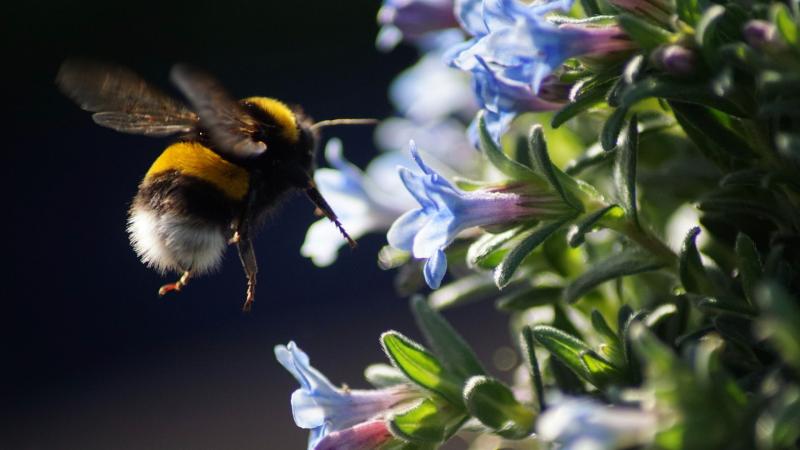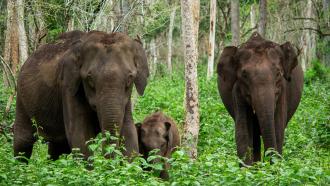
Pollinators, pesky pests, thirsty bloodsuckers, disease carriers, nutrient recyclers—insects play diverse roles! While they make up about 80% of all multicellular organisms we know, they are also the fastest disappearing life forms. From an ecological perspective, we seem to have some idea about the vital role these flying critters play in our survival. However, we have barely understood how they navigate their environment with ease and what functions wind direction and odour play in guiding them. Now, a new study uses three-dimensional virtual reality to develop some insights into how insects fly.
In the study, published in the Proceedings of the National Academy of Sciences (PNAS), researchers from the National Centre for Biological Sciences (NCBS), Bengaluru, and Universität Bielefeld, Germany, have explored the search behaviour of flying insects. They have shown that insects can distinguish size and distance amidst a complex environment, and can also use cues from the blowing wind and odour to navigate. The study was funded by the Science and Engineering Research Board (SERB), Microsoft Research and the Department of Atomic Energy.
“Insects are one of the very few groups of organisms that have evolved mastery of the skies, which is one of the major contributors to their immense diversity,” says Dr Shannon B. Olsson, Associate Professor at NCBS, who led the study.
But studying their ability to fly poses many challenges and hence, there are very few studies on this.
"Because of their small size and speed, it is difficult to follow insects around in nature. It is also challenging to evaluate what an insect is seeing, smelling or feeling at any point in time," she cites.
The researchers solved this predicament by using virtual reality and simulating a real-world environment with three-dimensional objects to understand how flying insects navigate.
"Our setup allows us to measure what sights, smells, and air currents cause them to change direction," says Dr Olsson.
They glued a few insects to tiny rods and let them fly in a room with monitors that provided imagery of an open meadow with grass, sky and trees. They also simulated wind flow direction and odour around the insect using tiny glass capillaries that had valves to release bursts of air and odour. These capillaries also rotated around the insects as they moved.
The study is the first to use three-dimensional simulations in virtual reality to understand flying insects.
"It is essentially a video game that is controlled by the fly using its wings as a joystick," says Mr Pavan Kumar Kaushik.
He is a graduate student at NCBS and a coauthor of the current study.

A tethered apple fly approaching a tree-like virtual object. Computer monitors provide a visual panorama and glass capillaries provide 360º wind and odor cues. [Image credits: Pavan Kumar Kaushik]
Complex calculations in a pinhead-sized brain
The researchers conducted various experiments on many insects to test if they could navigate towards virtual objects. They started with a leashed apple fly (Rhagoletis pomonella), a North American pest. When it was shown a world of only grass and sky, it seemed to have no preference about where it wanted to fly. But when a tree was added to the environment, it approached the tree and attempted to land on it. The researchers then repeated this experiment with other flying insects, including a mosquito (Aedes aegypti), a species of crane fly (Pselliophora laeta), and a hoverfly (Eristalis tenax). They found that all of these insects could distinguish, navigate, and respond to virtual three-dimensional objects from the surrounding background.
Insects are known to have compound eyes with many light-sensitive units to help them see. Could this pixelated vision aid them in navigation?
"Compound eyes are particularly good at detecting motion. They see the world ten times faster than we do," says Mr Kaushik. "Coupled with ingenious neural circuitry, they compute complex image processing tasks much better than our best computer vision algorithms, with a brain smaller than a pinhead!"

Opo Terser / CC BY (https://creativecommons.org/licenses/by/2.0)
In the next set of experiments, the researchers introduced more trees at different distances and of various sizes in the virtual environment for apple flies to navigate. They found that these flies preferred to approach the nearest tree, although it was smaller. The researchers then blocked the visual cues by having a static background with no objects but only wind flow and odour. They found that the flies were using the direction of the wind and the smell to approach the desired object.
It is a commendable accomplishment for insects, who have primitive neural structure, to pull off such stunts.
"Insects are known to use their antennae coupled with visual cues to measure airflow. We show that they can do this without any visual cues," says Mr Kaushik on their finding.
Probably, that is how high flying and nocturnal insects, who cannot see well, might be able to measure the wind speed and the direction to migrate hundreds of kilometres, he says.
Deciphering the exact mechanism of how insects, which have only a few hundred thousand neurons in their brain, unlike 80 billion in ours, fly, is fascinating and has many implications.
"Understanding how flying insects navigate helps to know how they find flowers for pollination, crops to feed on, or arms to bite (in the case of mosquitoes). It can also help us learn to live more in harmony with them," says Dr Olsson.
Besides, it can also benefit the field of computer vision and robotics.
"Nothing humans have created to date has the computational prowess to navigate the world like a tiny little fly. But learning how they do it can help us create better technology that uses less computational power," she signs off.
This article has been run past the researchers, whose work is covered, to ensure accuracy.






